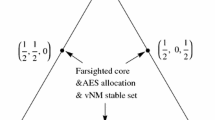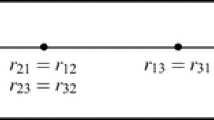Abstract
This paper provides an explanation for the emergence of political extremism in an environment in which a change in “ré gime” requires an investment that benefits more than one player. We show that in order to mitigate the effects of free riding, players may choose extreme positions. Further, we show that as the free rider problem becomes more severe, both parties move to more extreme positions in the same direction.
Similar content being viewed by others
References
Appelbaum, E. (2006). Extremism as a strategic tool in conflicts. York University discussion paper.
Appelbaum, E., & Weber, S. (1992). A note on the free rider problem in oligopoly. Economic Letters, 40(4), 473–480.
Atkinson, S. E., Sandler, T., & Tschirhart, J. (1987). Terrorism in a bargaining framework. Journal of Law and Economics, 30(1), 1–21.
Bandarage, A. (2004). Beyond globalization and ethno-religious fundamentalism. Development, 47(1), 35–41.
Berrebi, C., & Klor, E. F. (2004). On terrorism and electoral outcomes: theory and evidence from the Israeli-Palestinian conflict. Princeton University industrial relations sections, working paper, 480.
Bernheim, D. (1984). Strategic deterrence of sequential entry into an industry. Rand Journal of Economics, 15, 1–11.
Blomberg, S. B., Hess, G. D., & Weerapana, A. (2004a). An economic model of terrorism. Conflict Management and Peace Science, 21(1), 17–28.
Blomberg, S. B., Hess, G. D., & Weerapana, A. (2004b). Economic conditions and terrorism. European Journal of Political Economy, 20(2), 463–478.
Breton, A., Galeottiet, G., Salmon, P., & Wintrobe, R. (Eds.) (2002). Political extremism and rationality. New York: Cambridge University Press.
d’Aspremont, C., Gabszewicz, J., & Thisse, J.-F. (1979). On Hotelling’s stability in competition. Econometrica, 17, 1145–1151.
de Palma, A., Ginsburgh, V., Papageorgiou, Y., & Thisse, J.-F. (1985). The principle of minimum differentiation holds under sufficient heterogeneity. Econometrica, 53, 767–782.
Esteban, J., & Ray, D. (1999). Conflict and distribution. Journal of Economic Theory, 87(2), 379–415.
Feldmann, A. E., & Perala, M. (2004). Reassessing the causes of nongovernmental terrorism in Latin America. Latin American Politics and Society, 46(2), 101–132.
Ferrero, M. (2005). Radicalization as a reaction to failure: an economic model of Islamic extremism. Public Choice, 122(1–2), 199–220.
Frey, B. S., & Luechinger, S. (2003). How to fight terrorism: alternatives to deterrence. Defence and Peace Economics, 14(4), 237–249.
Gilbert, R. J., & Vives, X. (1986). Entry deterrence and the free rider problem. Review of Economic Studies, 53, 71–83.
Glaeser, E. L., Ponzetto, G. A. M., & Shapiro, J. M. (2004). Strategic extremism: why republicans and democrats divide on religious. National Bureau of Economic Research, Inc., NBER working papers: 10835.
Glazer, A. (2002). Strategic positioning and campaigning. In A. Breton et al. (Eds.), Political extremism and rationality (pp. 105–121). New York: Cambridge University Press.
Glazer, A., & Konrad, K. A. (Eds.) (2003). Conflict and governance. Heidelberg: Springer.
Glazer, A., Gradstein, M., & Konrad, K. A. (1998). The electoral politics of extreme policies. Economic Journal, 108, 1677–1685.
Hoffer, E. (1966) (first published in 1953). The true believer: Thoughts on the nature of mass movements, Harper and Row.
Hotelling, H. (1929). Stability in competition. Economic Journal, 39, 41–57.
Islam, M. Q., & Shahin, W. N. (2001). Applying economic methodology to the war on terrorism. Forum for Social Economics, 31(1), 7–26.
Lapan, H. E., & Sandler, T. (1993). Terrorism and signalling. European Journal of Political Economy, 9(3), 383–397.
Laussel, D. (2002). Delegation effects in representative democracies: do they foster extremism? Journal of Public Economics, 85(2), 191–205.
Mass-Collel, A., Whinston, M. D., & Green, J. R. (1995). Microeconomic theory. Oxford University Press.
Nozick, R. (Ed.) (1997). The characteristic features of extremism. In Socratic puzzles. Cambridge: Harvard University Press.
Oak, M. (2002). Essays in political economy and public policy. Ph.D., Cornell University.
Rothschild, M., & Stiglitz, J. E. (1971). Increasing risk II: Its economic consequences. Journal of Economic Theory, 3(1), 66–84.
Rubbelke, D. T. G. (2005). Differing motivations for terrorism. Defence and Peace Economics, 16(1), 19–27.
Sandler, T., & Enders, W. (2004). An economic perspective on transnational terrorism. European Journal of Political Economy, 20(2), 301–316.
Schelling, T. C. (1960). The strategy of conflict. Harvard University Press.
Shughart, W. F. (2006). An analytical history of terrorism, 1945–2000. Public Choice, 128(1–2), 7–39.
Victoroff, J. (2005). The mind of the terrorist: a review and critique of psychological approaches. Journal of Conflict Resolution, 49(1), 3–42.
Waldman, M. (1987). Non-cooperative entry deterrence, uncertainty and the free rider problem. Review of Economic Studies, 54, 301–310.
Westermark, A. (2004). Extremism, campaigning and ambiguity. Games and Economic Behavior, 47(2), 421–452.
Wintrobe, R. (2006a). Rational extremism: the political economy of radicalism. Cambridge University Press.
Wintrobe, R. (2006b). Extremism, suicide terror, and authoritarianism. Public Choice, 128(1–2), 169–195.
Author information
Authors and Affiliations
Corresponding author
Rights and permissions
About this article
Cite this article
Appelbaum, E., Katz, E. Political extremism in the presence of a free rider problem. Public Choice 133, 31–40 (2007). https://doi.org/10.1007/s11127-007-9175-8
Received:
Accepted:
Published:
Issue Date:
DOI: https://doi.org/10.1007/s11127-007-9175-8




